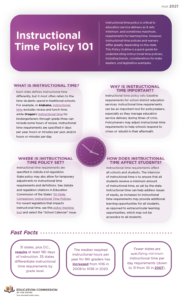As the state budget season approaches and the American Rescue Plan has been enacted, it’s worth taking a look at how states are thinking about K-12 funding for the upcoming fiscal year. We explored this in our latest Policy Snapshot on K-12 Funding Policy Responses to COVID-19, which detailed how states are grappling with attendance/enrollment, revenue and equity-based funding initiatives during the pandemic. While some of these concerns have been alleviated by Congressional action, some of the trends we saw in 2020 have continued.
Attendance and Enrollment
In many states, counting attendance to measure year-to-year changes in enrollment is how states allocate funds to schools. However, a unique consequence of the COVID-19 pandemic is a significant enrollment decline in public schools, which decrease the amount of funding they are allocated. A survey of 33 states shows enrollment has dropped by more than 500,000 students, or 2% of the national student population. One estimate suggests the actual total may be as high as 3 million students — or 6% — who have not attended classes since the widespread adoption of remote learning in March 2020. During a normal school year, a 1% decline in enrollment is difficult for a district to handle financially; some districts have already reported declines as much as 5%, leading to furloughs and layoffs.

Learn more about how to use instructional time policies to address loss of learning opportunities and supports.
Just like we saw in 2020, states continue to pursue hold harmless policies, which maintain state funding levels based on the prior year’s enrollment count. During this year’s legislative session, we have tracked legislation that would hold districts harmless in at least 19 states, and of those, seven states’ bills have already been enacted.
In addition, some states had existing policies in place prior to the pandemic that guarantee districts do not lose funding or cap funding losses. While these policies have traditionally buoyed districts’ finances in the face of crisis, pandemic-induced changes in enrollment and measurements of students from low-income households complicate policymakers’ attempts to target districts and students who are most in need.
Revenue
In good news, many states have not only avoided dire revenue losses but have collected as much or more revenue as they did before the pandemic. This dynamic has translated into states considering better than expected state education budgets, which could enable even more states to pursue hold harmless policies. This is not true of every state, however, as some states are experiencing acute revenue declines because of their reliance on certain revenue sources and other economic factors. For instance, a state like Alaska, which relies on oil and gas taxes, has seen a large decline because of a fall in natural resource prices. Additionally, states like Florida and Hawaii have seen a large decline in sales tax collections because of decreased tourism.
Despite the impending infusion of federal relief dollars and a better-than-expected fiscal situation, states continue to propose legislation related to education revenues. The majority of proposed legislation encompasses modifications to existing revenue streams and requirements, such as increasing income tax deposits to state education funds or requiring localities to increase property taxes to qualify for state education funding. We have seen a few states that are attempting to create new revenue streams — through legalized sports gambling, sin taxes and progressive income taxes — and allocate a portion of the proceeds to education.
Ultimately, these early trends in K-12 funding reveal how much expectations have changed since last year. Instead of the dire budgetary outlook many were anticipating, state policymakers are preparing to reopen schools and address student wellness and inequitable learning loss this spring and summer. While these are by no means easy tasks, at the very least, many states are in the fiscal position to begin this work instead of asking schools, teachers and students to do even more with less.









